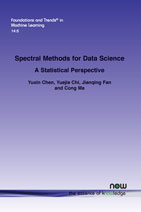Spectral Methods for Data Science: A Statistical Perspective
By Yuxin Chen, Princeton University, USA, yuxin.chen@princeton.edu | Yuejie Chi, Carnegie Mellon University, USA, yuejiechi@cmu.edu | Jianqing Fan, Princeton University, USA, jqfan@princeton.edu | Cong Ma, University of Chicago, USA, congm@uchicago.edu
Abstract
Spectral methods have emerged as a simple yet surprisingly effective approach for extracting information from massive, noisy and incomplete data. In a nutshell, spectral methods refer to a collection of algorithms built upon the eigenvalues (resp. singular values) and eigenvectors (resp. singular vectors) of some properly designed matrices constructed from data. A diverse array of applications have been found in machine learning, imaging science, financial and econometric modeling, and signal processing, including recommendation systems, community detection, ranking, structured matrix recovery, tensor data estimation, joint shape matching, blind deconvolution, financial investments, risk managements, treatment evaluations, causal inference, amongst others. Due to their simplicity and effectiveness, spectral methods are not only used as a stand-alone estimator, but also frequently employed to facilitate other more sophisticated algorithms to enhance performance.
While the studies of spectral methods can be traced back to classical matrix perturbation theory and the method of moments, the past decade has witnessed tremendous theoretical advances in demystifying their efficacy through the lens of statistical modeling, with the aid of concentration inequalities and non-asymptotic random matrix theory. This monograph aims to present a systematic, comprehensive, yet accessible introduction to spectral methods from a modern statistical perspective, highlighting their algorithmic implications in diverse large-scale applications. In particular, our exposition gravitates around several central questions that span various applications: how to characterize the sample efficiency of spectral methods in reaching a target level of statistical accuracy, and how to assess their stability in the face of random noise, missing data, and adversarial corruptions? In addition to conventional ℓ2 perturbation analysis, we present a systematic ℓ∞ and ℓ2,∞ perturbation theory for eigenspace and singular subspaces, which has only recently become available owing to a powerful “leave-one-out” analysis framework.
Spectral Methods for Data Science: A Statistical Perspective
In contemporary science and engineering applications, the volume of available data is growing at an enormous rate. Spectral methods have emerged as a simple yet surprisingly effective approach for extracting information from massive, noisy and incomplete data. A diverse array of applications have been found in machine learning, imaging science, financial and econometric modeling, and signal processing.
This monograph presents a systematic, yet accessible introduction to spectral methods from a modern statistical perspective, highlighting their algorithmic implications in diverse large-scale applications. The authors provide a unified and comprehensive treatment that establishes the theoretical underpinnings for spectral methods, particularly through a statistical lens.
Building on years of research experience in the field, the authors present a powerful framework, called leave-one-out analysis, that proves effective and versatile for delivering fine-grained performance guarantees for a variety of problems. This book is essential reading for all students, researchers and practitioners working in Data Science.
